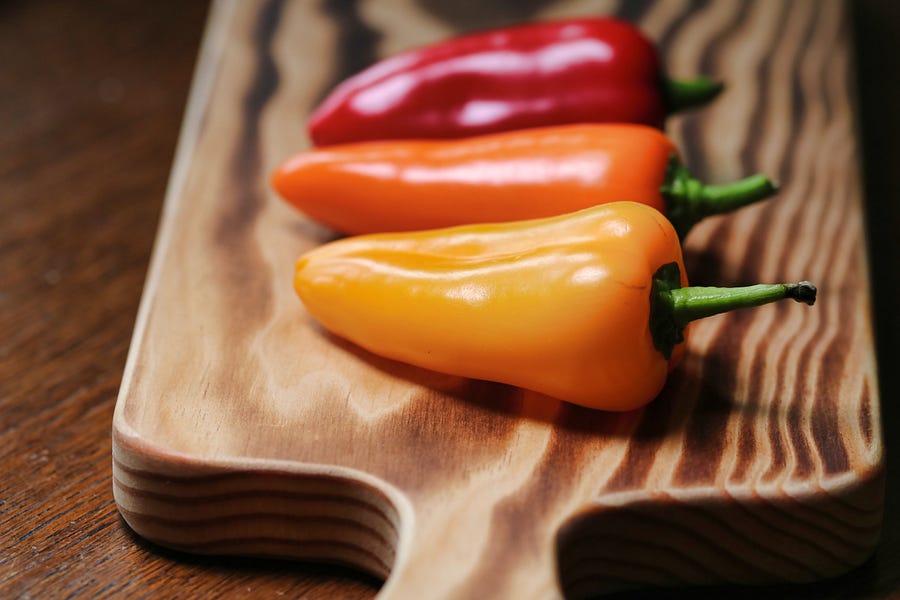Understanding the goodness of pepper
Peppers are botanically a fruit since they contain seeds and develop from the fertilised ovary of a flower. But because they are used in savoury cooking we consider them veggies. Sweet peppers, in particular, are absent of significant spiciness, that’s why they form their own category.

Main varieties of sweet peppers
- All colours of bell peppers (capsicums)
- Miniature sweet peppers
- Cubanelle peppers
- Pimiento peppers
- Sweet banana peppers
- Jimmy Nardello peppers
Cooking
Sweet peppers are versatile vegetables that can be used in various dishes to add colour, flavour and nutritional value.
My favourite way to eat peppers is stuffed with quinoa, veggies and vegan minced meat.
There is barely a limit on what you can do with peppers. You can enjoy them
- in stir-fries and sauteed
- in salads
- stuffed with rice, quinoa, couscous
- grilled
- roasted
- as a pizza topping
- in tacos, burritos and Mexican dishes
- blended to create sauces for pasta
- pickled
- as a snack with hummus for dip
- some even use them in desserts
…the options are almost endless.
Health Benefits
Sweet peppers are rich in antioxidants, including vitamin C and carotenoids, which can help protect against certain chronic diseases and oxidative stress.
They also contribute to digestive health. Sweet peppers provide dietary fibre vital in supporting a healthy digestive system. Fibre aids digestion by promoting bowel regularity and preventing constipation. It also acts as a prebiotic, providing nourishment for beneficial gut bacteria. These bacteria help maintain a balanced gut microbiota, which is key for overall digestive wellness.
Especially when eaten raw, they help with overall body hydration due to their high water content. Each pepper consists of 85–90% water!
Being low in fat, peppers are also great for heart health and keeping cholesterol levels balanced.
Bloating
Peppers, especially certain varieties like bell peppers, contain compounds known as FODMAPs (fermentable oligosaccharides, disaccharides, monosaccharides, and polyols). Those are types of carbohydrates that can ferment in the gut and cause gas, bloating, and other digestive discomfort in some people, particularly those with irritable bowel syndrome.
Note that raw peppers are generally more difficult to digest.
Did you know that…
..bell peppers have a significantly higher content of vitamin C than oranges? They are an excellent source and can be a great way to reach your daily vitamin C requirements.
- Green bell peppers contain ~80mg/100gr
- Red bell peppers contain ~130mg/100gr
- Yellow bell peppers contain ~185mg/100gr.
Whereas 100 grams of orange contains just about 53mg of vitamin C.
Sweet pepper facts
- Sweet peppers were first domesticated in Central and South America and later introduced to Europe by Christopher Columbus after he returned from the Americas.
- The Kakadu plum, a variety of peppers native to Australia, contains 3,000–5,300mg of vitamin C per 100 grams. It is mostly used in powder form as a component of nutritional supplements.
- Bell peppers come in different colours, such as green, red, yellow, orange, and even purple. The colour variation, in some cases, indicates the different stages of ripeness.
- Generally, they are very low in calories and quite filling, which makes them a great addition to a weight management diet.
- Botanically speaking, as mentioned above, sweet peppers are fruits because they develop from the fertilised ovary of a flower. However, they are often referred to and used as vegetables in culinary contexts.
Thank you for reading and supporting our love for vegan nutrition.
If you want to know more about our nutrition programs, visit activeplantbased.
─ activeplantbased 🐇

